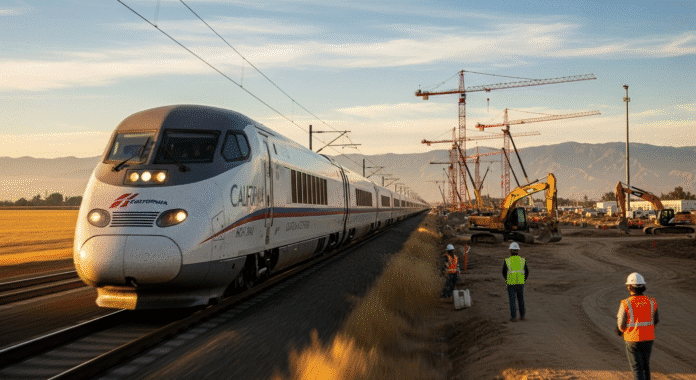California’s$4 Billion Rail Lawsuit Reveals the Real Barriers to American Progress
Why does a nation known for innovation fall behind in building modern, fast trains? California’s lawsuit against the Trump administration over a $4 billion clawback dives into this very question. The case is far more than a legal dispute—it reflects deep challenges in American infrastructure and exposes powerful industry interests that keep us locked into old ways. As Governor Gavin Newsom declared, “This is about more than a train. It’s about whether we’re going to lead or fall further behind.” Discover the forces at work and the choices that will shape America’s future.
California’s High-Speed Rail Lawsuit: More Than a Legal Battle
The Stakes
In July 2025, Governor Gavin Newsom filed a groundbreaking lawsuit challenging the Trump administration’s decision to withdraw $4 billion in federal funding from California’s high-speed rail project. The federal government justified this action by alleging mismanagement, repeated deadline failures, and untenable cost overruns. Despite these claims, California defended its progress, noting that the state had already generated over 15,000 jobs and completed 50 major structures, with 171 miles of the project under active construction.
The Political Divide
This lawsuit is not merely about dollars and cents; it represents a fundamental clash between differing visions of America’s transportation future. On one side, Newsom and supporters argue that the funding agreement is legally binding and vital to ushering in a sustainable, interconnected transportation network. On the other, the Trump administration branded the project a “boondoggle” and a “train to nowhere,” echoing broader federal reluctance to invest in large-scale infrastructure projects.
The dispute has ignited heated debates in courtrooms and public forums alike, highlighting a stark political divide that extends beyond California’s borders. It underscores the tension between a forward-looking vision of clean, efficient transit and an entrenched system favoring traditional transportation methods.
Why the U.S. Lags Behind: Policy, Money, and a Persistent Mindset
Fragmented Policy and Lack of National Vision
Unlike nations that boast seamless high-speed rail networks—such as Japan’s Shinkansen or China’s expansive network—the United States lacks a centralized strategy. American rail projects often stem from fragmented state and local efforts rather than a coherent national plan. This piecemeal approach leads to misaligned priorities and inconsistent federal backing. In regions where political leaders oppose bold investments, high-speed rail projects can quickly sputter before they even start.
Funding Challenges and Cost Overruns
Funding remains one of the biggest hindrances to high-speed rail development in the U.S. Take California as an example: what began as a $33 billion project has now soared to an estimated$128 billion. Lengthy environmental reviews, complex permitting processes, and persistent political wrangling have all conspired to drive up costs and extend timelines. In contrast, countries like China benefit from streamlined processes that allow them to rapidly expand their rail networks.
Outdated Infrastructure That Doesn’t Meet Today’s Needs
The majority of America’s rail infrastructure was originally designed for slow-moving freight, not for high-speed, passenger-focused transit. Modernizing these systems—or building new dedicated lines—demands huge sums of money and extensive planning. Urban sprawl and decades-old rail networks stand in sharp contrast to countries that have continuously updated their infrastructure to keep pace with modern technology and the needs of their citizens.
Cultural Preferences and Industry Influence
American culture is deeply rooted in automobile travel and air transportation. Generations have been conditioned to favor the flexibility of car travel and the speed of air transit, and this mindset is reinforced by powerful industry interests. Big oil companies and the airline industry have long lobbied against investments in rail infrastructure—efforts that have significantly influenced political decisions and public perceptions.
The Real Cost: Consequences of Falling Behind in High-Speed Rail
Economic Implications
High-speed rail projects are economic catalysts. During construction alone, such projects can create thousands of jobs while simultaneously boosting local economies. Nations that have embraced rail innovations, like China or Spain, have seen business opportunities arise from better connectivity and reduced travel times. In the United States, however, reliance on inefficient automotive and air travel systems limits growth and leaves many regions struggling to attract modern industries.
Environmental Impact
Transportation is one of the largest sources of carbon emissions in the United States. High-speed rail presents a cleaner alternative, emitting far less CO₂ per passenger mile than both cars and planes. Countries with advanced rail systems, such as France and Japan, have reaped the benefits of reduced air pollution and lower overall carbon footprints. America’s continued dependence on outdated transportation methods hampers efforts to combat climate change and undermines national sustainability goals.
Social and Quality of Life Factors
For millions of Americans, long commutes and extended travel times have become a way of life. High-speed rail could transform daily routines by drastically reducing travel time between major cities—allowing for a better work-life balance, more leisure time, and improved overall quality of life. Additionally, enhanced connectivity can bridge the gap between urban and rural areas, offering equitable access to education, healthcare, and economic opportunities.
Missed Opportunities for Innovation and Global Leadership
In a world racing toward innovative infrastructure, the United States risks becoming a bystander. While countries like China have built more than 30,000 miles of high-speed rail in just two decades, America’s hesitation leaves it vulnerable in the global market. The chance to lead in next-generation transportation, to foster urban renewal and advanced technological integration, is slipping away—unless bold reforms are enacted.
Who’s Keeping High-Speed Rail Off Track? The Influence of Oil and Airline Industries
Imagine a scenario set in a high-rise boardroom in Washington, D.C. Executives from major oil corporations and leading airlines gather with influential lobbyists. Their mission is clear: to safeguard their profits and maintain established transportation methods that fuel their bottom lines.
One executive from a top oil company warns, “High-speed rail could drastically reduce our market share by curbing fossil fuel demand. We simply cannot allow that.” An airline lobbyist chimes in, “Short-haul flights are our core, and high-speed rail easily competes with these routes. We must act now to protect our investments.” These discussions lead to a coordinated lobbying campaign aimed at casting high-speed rail as an untested, costly, and ultimately impractical alternative to traditional transportation.
This scenario is far from fictional. Historical evidence underscores such maneuvers. Southwest Airlines, for instance, has famously lobbied against high-speed rail projects in Texas—once even threatening to relocate its headquarters if a rail initiative moved forward. Oil companies, too, have funneled funds into political campaigns designed to stoke skepticism about rail electrification and other green infrastructure efforts.
The results have been telling. Political debates are shifted by well-funded advertising campaigns that highlight exaggerated risks and delay critical funding. Public perception is swayed, leading voters to question the feasibility of modern rail systems. In essence, while America stands at a crossroads, powerful interests work tirelessly to ensure that the nation remains locked into outdated transportation modes.
Counterarguments and the Way Forward
Critics argue that high-speed rail is an impractical investment for a nation as vast as the United States. They cite high costs, logistical challenges, and uneven population densities as major obstacles. However, the real cost of inaction is evident in growing environmental degradation, worsening congestion, and lost economic opportunities.
Countries that lead in high-speed rail show what’s achievable with vision, strategic investment, and the political will to challenge entrenched interests. The debate isn’t simply about choosing one mode of transportation over another—it’s about building a future that prioritizes sustainable innovation, improved quality of life, and true economic progress.
The evidence is clear, and the necessity for change is compelling. By mobilizing public support and demanding accountability from elected officials, American citizens can help steer policy in a direction that embraces modern, efficient transportation.
Time to Get America Back on Track
California’s lawsuit against the Trump administration is more than a legal dispute—it is a wake-up call. It spotlights the barriers, both political and economic, that keep America trailing behind other nations in high-speed rail. It also lays bare the forces of big oil and airline industries, whose lobbying efforts have stymied progress in favor of maintaining outdated transportation systems.
The decision before us is critical. Will the United States continue to allow powerful interests to dictate our transportation future, or will we invest in a cleaner, faster, and more connected nation? The choice is clear. Now is the time to act. Let your voice be heard. Demand that our leaders prioritize high-speed rail and forge a path toward a more innovative, sustainable America.




